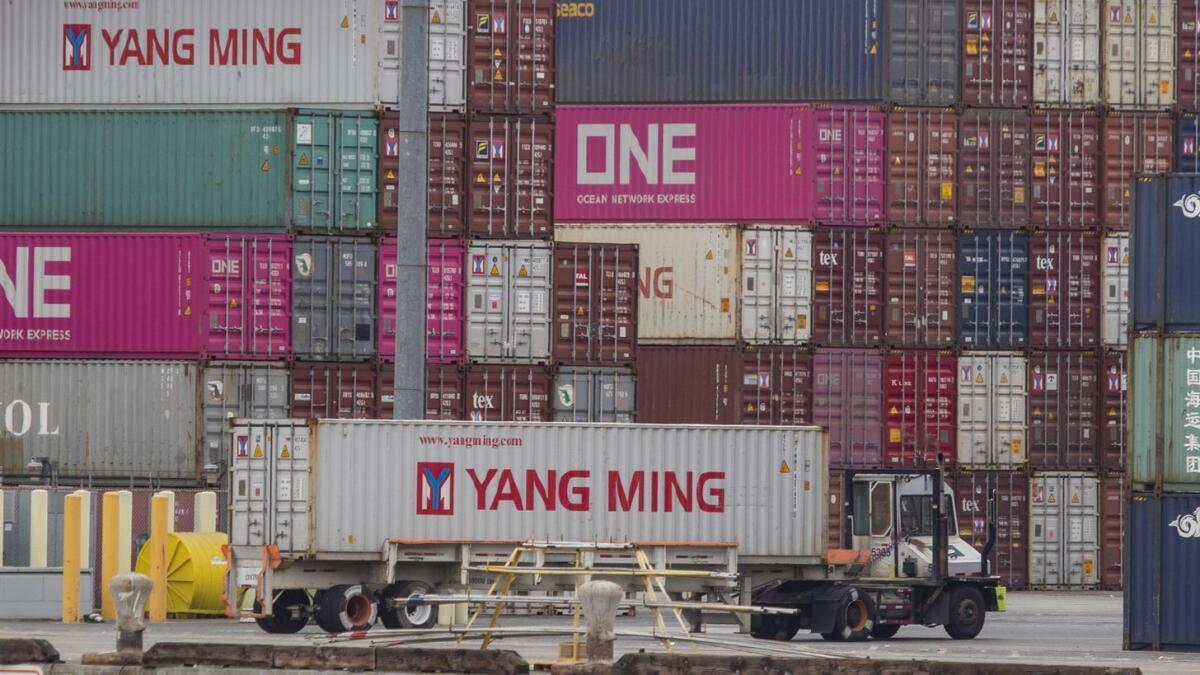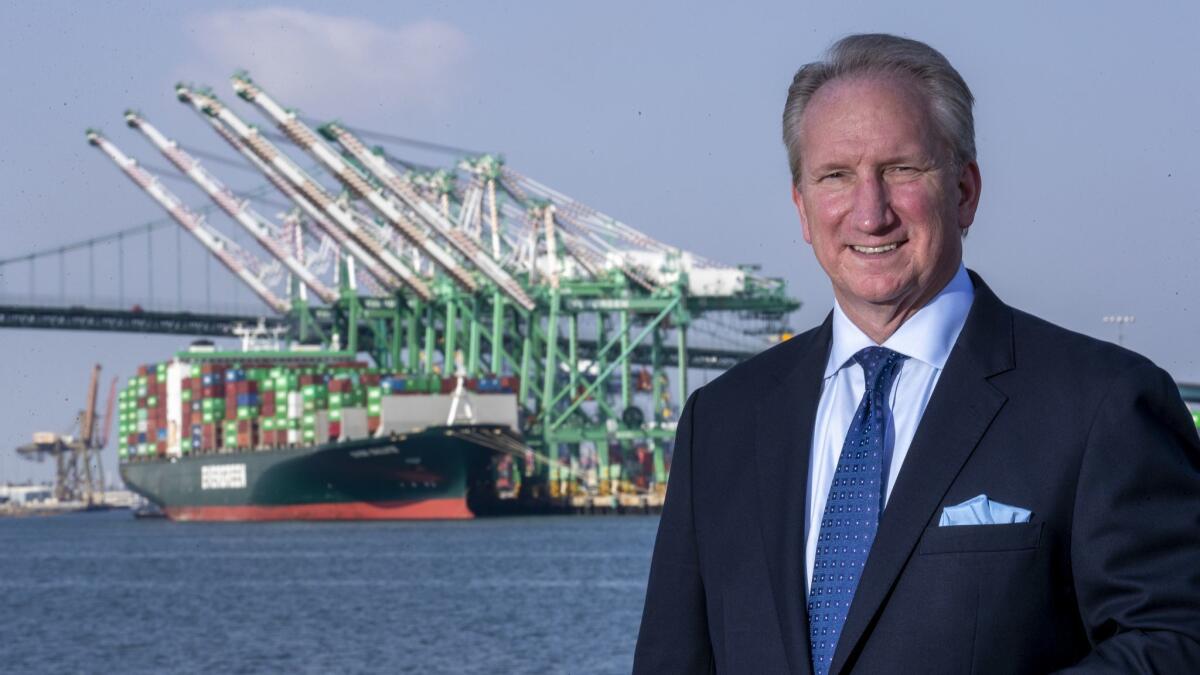Must Reads: In Trump’s trade war with China, L.A. ports are ground zero

When President Trump unveiled plans to launch a trade war with China early last year, Marisa Bedrosian Kosters, an executive at an Anaheim-based ceramic tile and stone retailer, sprang into action.
Like many of the tens of thousands of retailers who move Chinese goods through Southern California’s giant port complex, Bedrosians Tile and Stone turbocharged its imports to get ahead of the threatened tariffs and other duties.
But when its new supplies from Foshan reached the Port of Long Beach, the company, which has outlets in 10 states, ran into a massive traffic jam. With thousands of extra containers piled up dockside, Kosters struggled to get her tiles off ships and onto trucks, incurring thousands of dollars in extra costs assessed by the terminals. And now she faces a supply glut. Her 389,000-square-foot tile distribution center is overflowing, and she has had to store more than 7,500 pallets outside.
“There’s no space inside,” she said. “We don’t have anywhere to put the materials.” Meanwhile, despite the bottlenecks, “We’re having to bring in more because there’s so much uncertainty about what country is being hit next.”
Perhaps nowhere in the United States is the tariff war with China having a more tangible effect than at the twin ports of Los Angeles and Long Beach, the nation’s leading gateway for trans-Pacific trade. The complex handles 47.5% of U.S. containerized trade with China — including toys, bicycles, furniture, electronics, sneakers, scrap paper, cotton, soybeans and auto parts.
The tariffs have thrown a giant wrench into Southern California logistics industries, rippling through a broad web of companies that handle shipping, trucking, railroads, warehousing, construction, manufacturing and farming. Nearly a million jobs in the five-county region are tied to international trade.
The tariff fallout has “really gummed up the operations of the supply chain,” said Eugene Seroka, executive director of the Port of Los Angeles. “We’ve got a lot of cargo coming in that just sits. Containers are stacked high. Truck lines are long. And warehouses are bursting at the seams.”
Southern California’s warehousing and distribution complex, the largest in the world with 1.8 billion square feet within 50 miles of the ports, has less than 1% vacancy, down from the usual 5% to 7%, he added.
The effect on corporate decision making may be less visible, but it is worrisome, Seroka said.
“A lot of money is sitting on the sidelines,” he said. “Do you buy more trucks? Do you hire more people? Do you build another warehouse? Do you invest in digital technology? Few companies want to invest at this point in time in the supply chain, not knowing where it is going in the future.”

Over more than a century, the twin ports, which moved $506 billion worth of goods for 212,000 companies last year, have thrived. Container traffic last year reached record levels. The more than 17.5 million units of cargo that moved in 2018 marked a 20% increase over five years ago.
But since last April, as the Trump administration began slapping tariffs on Chinese products — eventually escalating them to 25% on $250 billion worth of goods — the ports’ growth pattern has been upended. China pushed back with tariffs on $60 billion worth of U.S. exports.
At the twin ports, containerized imports from China surged in the summer and fall, and then fell by 11.9% in the first four months of this year compared with the first four months of 2018.
Over the same period, exports to China plummeted by 27.4%.
Now Trump’s threat to tariff an additional $300 billion in Chinese imports is creating even more uncertainty. It would mean a tax on nearly everything that the U.S. buys from China and would probably trigger more Chinese retaliation.
“There is a lot of concern about jobs,” said Mario Cordero, executive director of the Port of Long Beach. “We have 10,000 dockworkers. If they’re not called to do work, they don’t earn money. The less cargo we have, the less demand for logistics workers, for warehouse workers. Whether you’re a trucker or a clerk or you work in manufacturing, the tariffs affect the whole supply chain.”
Jock O’Connell, a trade expert at Beacon Economics, a Los Angeles consultancy, foresees “a prolonged and bruising period of trade turbulence” between the U.S. and China. Tariffs on the additional $300 billion in Chinese goods could take effect as early as July, he said, and another import surge could tie up California ports as companies seek to get ahead of the new taxes.
As China retaliates, it will hammer companies that had identified that fast-growing nation as a prime opportunity for expansion. “It won’t have a catastrophic effect on the Southern California economy,” O’Connell said. “But if you are a company struggling to do business with China, it could be devastating.”
Although they have set records for growth, largely thanks to imports from China, the Southern California ports have lost market share in recent decades to competitors on the East and Gulf coasts and in Canada and Mexico. The trend accelerated after a 2014-15 labor conflict that led to massive congestion.

Logistics experts worry that tariff-related bottlenecks could encourage shifts to other ports.
“The supply chain needs a lot of work,” said Weston LaBar, CEO of the Harbor Trucking Assn., which represents several hundred local trucking firms. “Now we’re seeing many of the same issues we saw during the complete gridlock in late 2014 and early 2015.”
But not as severe. Then, ships stacked up for days, unable to unload as dockside work slowed during contentious contract negotiations between the shipping industry and the International Longshore and Warehouse Union.
But as with that earlier snarl-up, tariffs are a threat to the intricate manufacturing supply chain that the ports support, LaBar said.
“So, for instance, China imports scrap metal from the U.S. and recycles it into slab steel. A steel company in Los Angeles imports it back from China and turns it into rolled steel for the aerospace industry,” he said.
“Now that L.A. company, because of the China tariffs, has had to source steel from Brazil. But there’s a cap on how much slab steel they can import from Brazil. And there are hundreds of manufacturers all over the country looking at layoffs because of these tariffs.”
Snafus at the port complex have been “a nightmare,” said Steve Hughes, president and CEO of HCS International, an auto parts consultancy. As companies scrambled to get ahead of the tariffs by ordering months’ worth of inventory, containers normally stacked three or four high after being unloaded from a vessel were piled seven high, he said.
“Imagine yours is at the bottom: You have to unload and stack six others before you can get to it,” Hughes said. “One client called me at the end of January. A large importer in Torrance. He had 10 or 15 containers stuck inside a terminal since November. They were actually lost.”
When the containers were finally found, Hughes added, the terminal, owned by a global shipping company, charged the importer tens of thousands of dollars for exceeding the usual three-day storage window. Under the controversial practice known as “demurrage,” Hughes said, “you have to pay before you can pick them up. You are blackmailed.”
The import surge also spurred ocean carriers to ignore agreed-to rates in signed contracts with cargo owners, Hughes said.
“Freight volumes went up,” he said. “Ships were full. Rates went from about $1,000 per container unit to $2,000. If you didn’t pay, your cargo sat in Asia.”
As the trade war escalates, the most economically vulnerable workers will suffer, predicted O’Connell, the Beacon Economics trade expert.
“Truck drivers are paid by the load, and fewer loads impact their income,” he said. “And warehouse workers from Los Angeles and the Inland Empire up to the San Joaquin Valley are mostly temps. They are sent to work by temp agencies on demand, and they are sent home when the number of boxes declines.”
Despite talk of moving supply chains from China to Vietnam, Malaysia, Bangladesh or West Africa, he said, “How fast can you build a new manufacturing facility and move all your component suppliers into a cluster in a new country? We are already starting to hit a wall in Vietnam where the transportation sector — with inadequate roads and ports — is overwhelmed.”
Trump has contended that U.S. manufacturers can fill the void as importers exit the China trade. But like many U.S. business executives, Kosters, the Anaheim tile merchant, doesn’t see how.
“For ceramic and porcelain tile, domestic producers currently only have capacity to produce about 30% of the U.S. market demand,” she said. “China is the largest exporter of ceramic tile to the U.S. [with] 31.5% of U.S. imports in square feet in 2018.”
Sourcing her inventory from other countries would mean “discontinuing more collections than I would like to think about and having to trash tens of millions of dollars in marketing materials,” she said. “Our company will also need to reinvest millions of dollars in marketing collateral for new replacement collections.”
Kosters is keeping a stiff upper lip.
“We’re doing the best we can to anticipate what the next moves will be and what other countries might be affected, or product segments,” she said. “We’re going to come out fine on the other side, but it’s still a huge, huge transition.”
Twitter: @margotroosevelt
More to Read
Inside the business of entertainment
The Wide Shot brings you news, analysis and insights on everything from streaming wars to production — and what it all means for the future.
You may occasionally receive promotional content from the Los Angeles Times.











